STRATEGY ARTICLE | Leaders must think of ‘vision’ and culture’ as the ‘operating system’ of their organisations
How our VisionOS® framework can transform your corporate vision and culture into your most valuable strategic asset.
How does vision influence a company’s strategy, culture, governance and future?
A new paradigm around corporate vision and culture is needed.
What is a vision? What is culture? No one knows for sure. Even in the modern world of the 21st century, “corporate vision” and “corporate culture” do not have a clear definition.
‘Vision and culture’ are still highly complex concepts and rarely well managed in companies. But both vision and culture require skills that both strategic planning units and HR departments do not have—expertise in developing ‘long term vision’ and seeing culture as a ‘holistic system’ and not just as a tool to monitor and motivate people.
Do corporate vision and culture even exist? As concepts, they are so undefined and create so much corporate disfunction that would it be better to scrap them. The lack of long-term strategic vision creates a dysfunctional culture and has huge effects on performance and business health.
We need to change the obsolete ‘vision and culture’ paradigm to provide leaders and organisations with a fresh and ‘cool’ approach to managing both. I say ‘cool’ because vision and corporate culture are surrounded by an ocean of useless jargon that no one understands. Vision and culture are currently ‘uncool’.
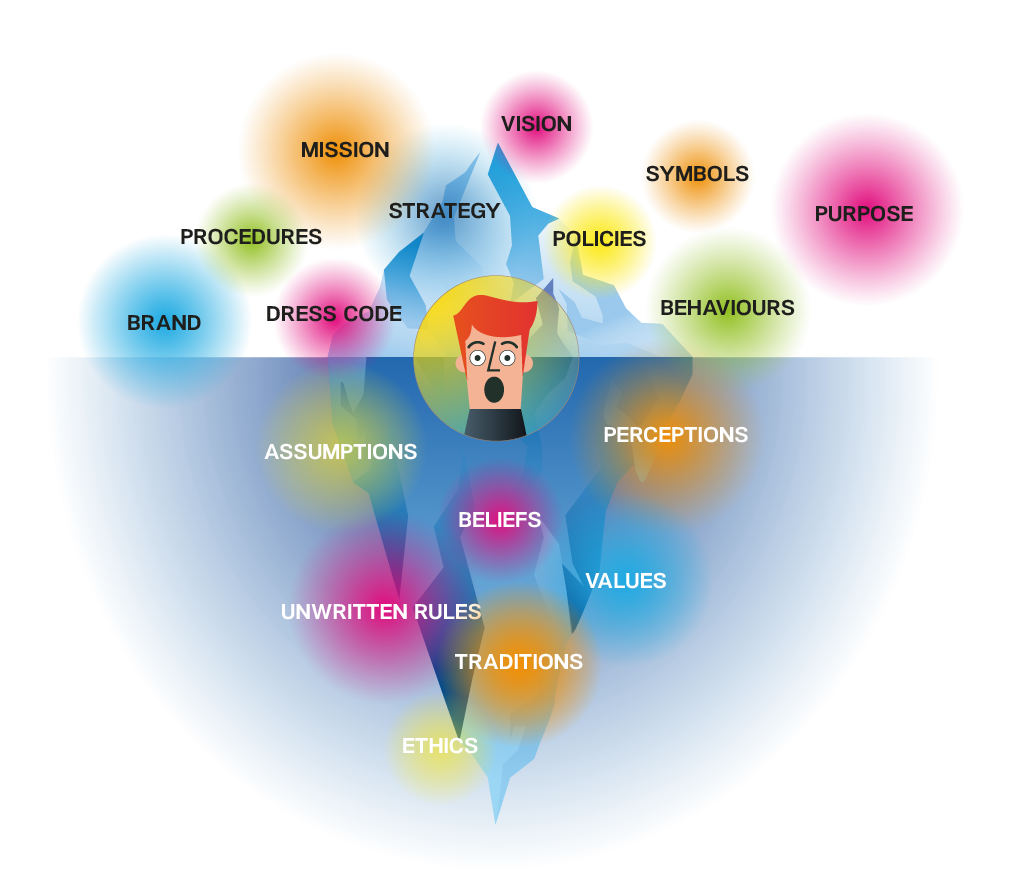
The ‘culture Iceberg’ is used in business to illustrate how culture is ‘a vague’ and unclear concept with some components of culture visible (above the water) and others invisible or unknown (submerged).
The problem with corporate vision and corporate culture
Corporate vision and culture are some of the least understood concepts in business. In my decades of experience as a strategic advisor to the world’s biggest brands and organisations on visioning, branding, business model innovation and culture transformation, I realised the significant flaws of the old, weak definitions and ‘status quo’ of ‘corporate vision’ and ‘corporate culture’. For business, vision is a vague and unclear concept that is usually reduced to a meaningless statement that does not translate strategically. Culture is like an invisible monster, let loose inside organisations and often cited or blamed for the bad things that happen. Lack of a clear and distinctive corporate vision can create mental blockages in management, governance, people and teams. Consequently, many organisations and their future have been damaged by poor strategic vision, leading to ‘reactive’ rather than ‘proactive’ cultures.
Businesses currently define corporate vision as a ‘vision statement’ rather than a journey of future discovery requiring future-oriented skills and tools, creative thinking and great entrepreneurial imagination. The usually weak ‘vision statement’ is given to the strategic planning team to show that the newly coined numbers include ‘the vision thing’. So, most strategic planning is done with little vision. We can see from the many companies with endless resources that do excellent strategic planning but lack strategic vision and fail to understand disruption and fast change. Most companies fail to realise that ‘strategy making’ and ‘strategic planning’ are two different things. Strategy making requires a ‘long range’ vision and worldview to incorporate the future. Only then can the ‘strategic planners’ take such vital information and produce a ‘plan’ to execute the strategic pillars of the vision.

Culture is also defined poorly as shared assumptions, symbols, values; norms; traditions, customs, incentives, the ‘behaviour of the tribe‘ or ‘how we do things around here’. These descriptions of culture are too narrow and do not help leaders incorporate or evaluate vision, and strategy, manage culture, governing organisations, or face future uncertainties. These poor definitions of vision and culture led management guru, Peter Drucker, to coin the phrase “Culture eats strategy for breakfast”. Drucker implied that your worst enemy is always inside; the lack of vision, the old mental models, methods, and ‘nostalgic’ ways of doing things (a visionless culture) stop progress in enterprises.

The ‘vision and culture’ problem is acerbated by dozens of tools that claim to create a vision or manage business culture but do not provide a holistic solution.
After researching much of the available literature around vision and culture, I realised that most academic and business books did not look at vision and culture as a holistic system with critical interconnections. They did not consider how changes to the external environment or how a company finances itself can affect its vision and culture. I realised the enormous yet unrealised power of discovering what ‘vision and culture’ really are for organisations and managing them in a new way.
I embarked on a three-year project to solve the ‘vision and culture puzzle’. I used a systems science approach (the study of complexity in systems) to examine the interaction of the corporate vision with the corporate culture and its associated components. I analysed hundreds of cases of companies and organisations that succeeded and failed to know how ‘vision and culture’ played a role in their success or demise. I realised that vision and culture operated in the background, providing different inputs and outputs to the ‘business system’ with diverse consequences depending on how those inputs and outputs were created, managed, or interpreted.
It is time to remove ‘vision and culture’ as a poorly managed idea in the Boardroom and the C-suite and elevate it as a critical tool for the leadership of the company to lead in the future. We need a new paradigm shift to define and manage both vision and culture.
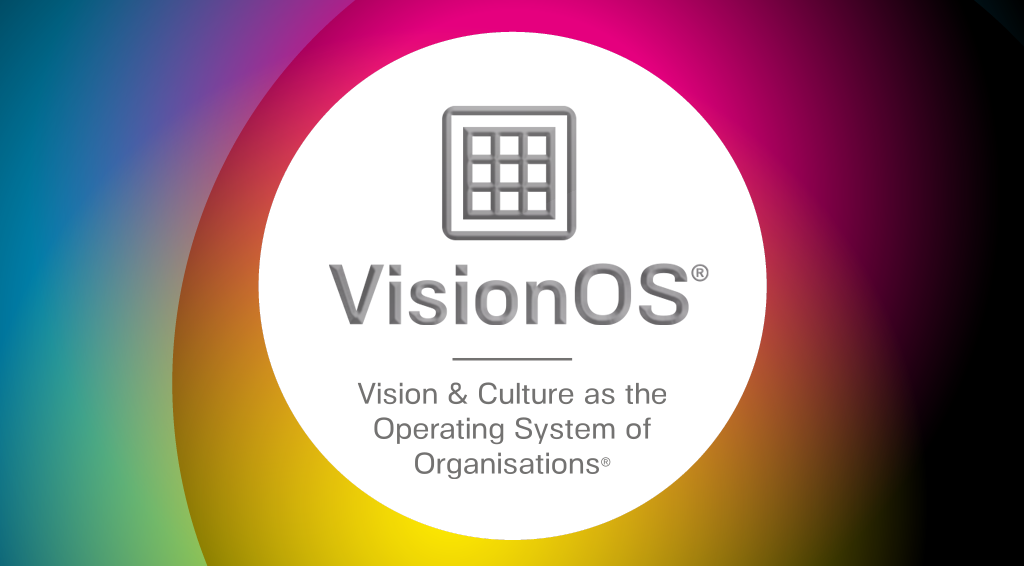
Vision and culture as an ‘operating system’ (The VisionOS®)
Vision and culture today are still lost in an ocean of business jargon. There is no clear or practical definition. To change the old ‘vision and culture’ paradigm and make such a complex topic more manageable, I propose that we change the way we think, describe, perceive, and manage corporate vision and culture. I suggest we treat them ‘AS THE OPERATING SYSTEM OF ORGANISATIONS’. Just like a mobile phone or a computer requires an operating system to work, organisational culture requires a powerful vision to direct all efforts. Many companies have reduced the importance of vision further by focusing on ‘purpose’ as the reason ‘why’ they exist. But focusing on ‘purpose’ is not enough. Purpose without ‘a vision of the future’ will not take you far away.
‘Vision’ is not just a statement and ‘culture’ is not just about ‘customs’, ‘rituals’, or incentives. A corporate vision operates in the background affecting and shaping organisational culture and directing people and stakeholders to do things and act in a certain way.
Think of vision & culture as your organization’s operating system (OS)

Thinking about vision and culture as an operating system makes a complex, intangible concept suddenly feel more real and grounded!
Vision drives strategy, purpose, values, and governance. Vision derives vital signals from the changing external environment and must direct what to invest in, create new core competencies, innovate the business model, and provide an organisational structure that supports performance and the behaviours of its people. Vision will tell you if your ‘purpose’ needs to be updated due to the changing environment.
Comparing vision and culture to an operating system (OS) improves how corporations understand their fundamental role in shaping the future. We improve how they understand ‘corporate culture’ and elevate the ‘vision thing’ to something more manageable and valuable, something that is more concrete and can be upgraded and improved regularly. It finally becomes a more ‘tangible’ strategic asset. It becomes cool’.

I developed the VisionOS® as the first operating system (OS) defining the corporate vision and cultural components that organisations must manage, coordinate and direct.
My new definition of vision is: “A corporate vision is the operating system (OS) of an organisation. The VisionOS® includes ten diverse, interdependent organisational components that affect each other and are influenced by constant internal and external inputs and outputs”.
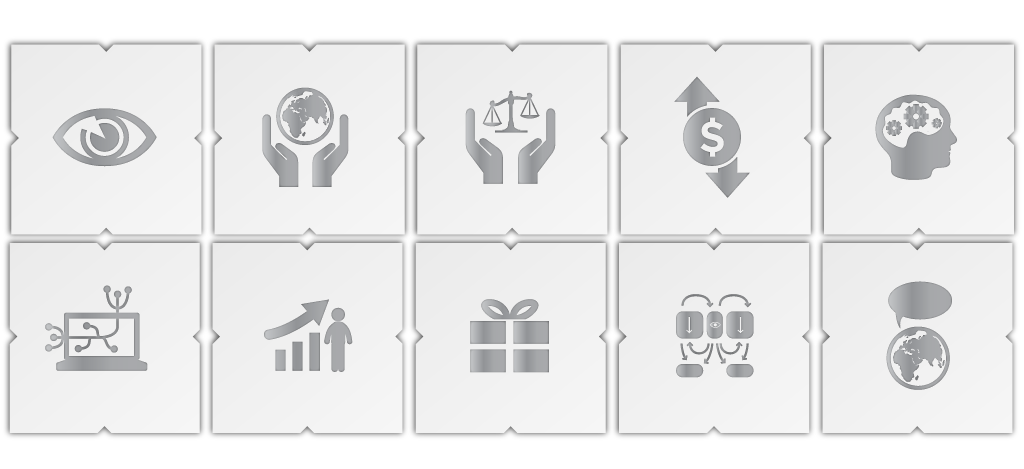
The VisionOS®
The ten components of the vision operating system.
The organisation’s corporate vision acts as the frame of the VisionOS® by describing the organisation’s long-term view and strategic roadmap. The rest of the VisionOS® components work in unison to support and achieve the corporate vision and innovate the culture.
The ten components of the VisionOS® are:
1 | The Corporate Vision
2 | Sustainable Purpose & Values
3 | Governance, Stakeholders & Policies
4 | Financial & Asset Management
5 | Core Competencies & Activities
6 | Structure & Enterprise Architecture
7 | People, Performance Metrics & Rewards
8 | Customers & Value Propositions
9 | Business Model
10 | Identity, Brand & Communications
The VisionOS®
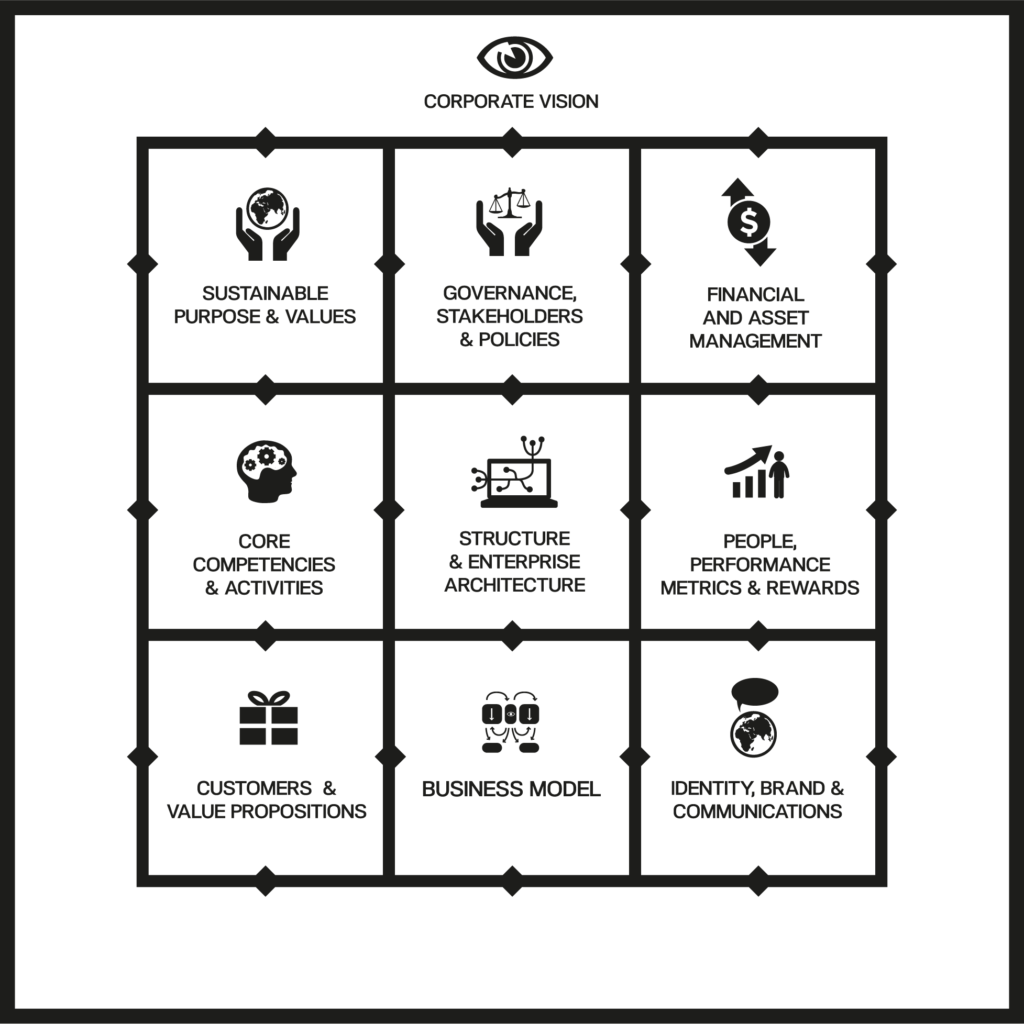
With this new description of ‘vision and culture’ and how they affect the organisation, we can define, diagnose, fix, and innovate a corporate vision and an organisational culture to prepare for the future. Like a computer’s operating system, the health of each component of the VisionOS® affects the performance of the whole and the balance of the entire company’s strategic, organisational and cultural state.
Managing ‘vision and culture’ as an “operating system”, also allows for the concept of “plug-ins” and “applications” (apps) to be possible for organisations, making “visions and cultures” open to enormous possibilities for change and innovation. Consequently, organisations can access external ecosystems, technologies and partnerships to enhance each of the ten VisionOS® components.
For example, a company can decide to manage all its technology infrastructure using ‘as a service’ cloud applications for most of its operational requirements. This operational move to ‘digital’ will directly impact the STRUCTURE AND ENTERPRISE ARCHITECTURE component of the VisionOS®, but will indirectly affect other components (i.e. the Business model, People performance, and rewards). So, as we change one element of the VisionOS®, the organisation must align the rest of the components in unison (i.e. proper training, townhall meetings, new incentives) to reduce internal resistance to the new technology and processes. The VisionOS® provides a method to look at corporate change holistically, showing that if you alter one component, the others are also affected and must be considered on how they affect the vision and culture of the organisation.

The VisionOS® and disruptive innovation
We can also use the VisionOS® to diagnose how well prepared the organisation, and its culture are to manage disruptive innovation. By understanding the VisionOS® components involved in disruptive innovation, a company can explore new ways to strengthen its core business while testing and building a future portfolio of opportunities and business models. Disruptive innovation is challenging but is an essential skill and mindset that companies need to learn. In disruptive innovation, a company can use synergies from its core competencies while also creating or acquiring new ones to develop new business models. Disruptive innovation happens mainly in five areas of the VisionOS® (see image below).

The VisionOS® test
How to diagnose the state of your present VisionOS® and preparing your organisation for the future.
Managing a corporate vision and culture like an operating system (OS) with clearly defined components helps to quickly diagnose what parts of the ‘corporate operating system’ are strong and which are weak. To identify weak, broken, or damaged aspects, I developed a diagnostic test that analyses the ten VisionOS® components to determine their current alignment or misalignment with the changes happening in the external environment.
With the VisionOS® matrix, we know how each component of the organisation affects the other parts positively or negatively in building the corporate vision and culture. This way, we can quickly assess how to fix and shape an organisation’s vision and organisational culture issues for the future.
Like in any operating system, if one part of the system is not aligned with the other parts, the system will falter or break and sometimes with dire consequences for the organisation. The VisionOS® diagnostic allows fixing and upgrading the different components to realign the VisionOS® to respond to the internal and external needs of the organisation and its stakeholders.
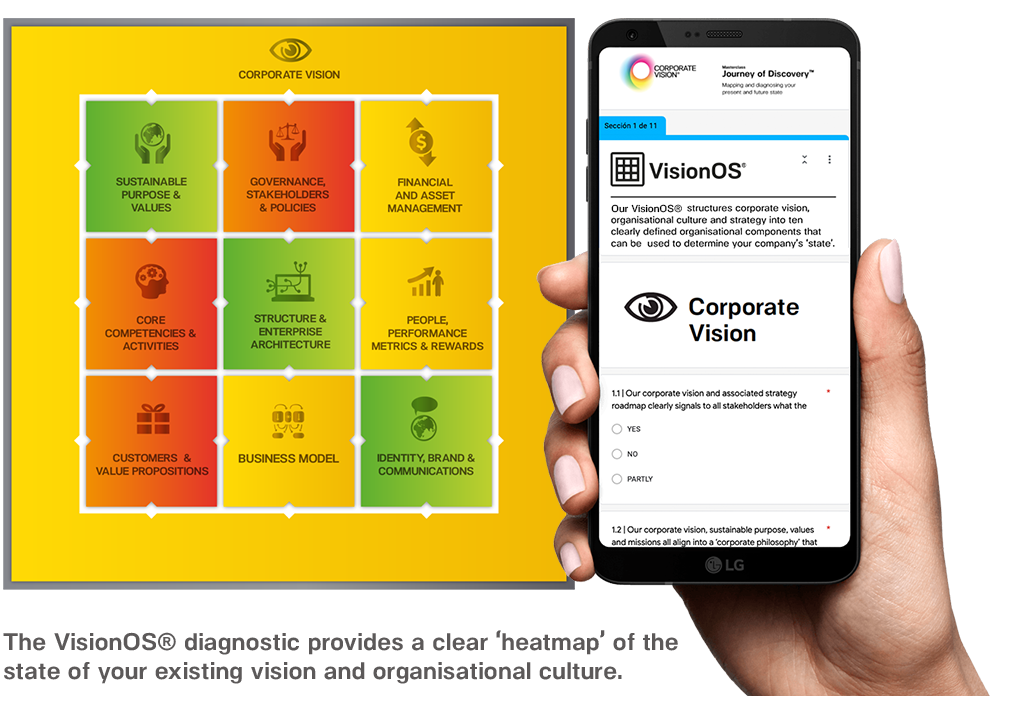
One VisionOS® framework. Infinite number of enterprises
The VisionOS® creates ‘a common framework’ so that we can analyse any corporate vision and culture using the same OS components. We can examine NASA, Google and Coca Cola using the VisionOS®. Therefore, we have created a common language (the VisionOS®) to diagnose, define, design, strategise, and manage the corporate vision and culture of diverse organisations for the future.
We should not think, though, that all enterprises are similar. Each VisionOS® is created in totally different ways. That is why companies can’t easily copy visions, cultures, business models and ‘secret sauces’. Samsung will never be Apple, Netflix will never be Disney, and Carrefour will never be Amazon. Different organisations’ ‘vision operating systems’ are created, organised and wired in totally different ways. Just like operating systems, ‘organisations’ are unique to their history, situation and the way they adapt to their external environment and the needs of their users.
Corporate vision and culture:
Why most mergers and corporate transformations don’t work
The lack of vision and inadequate management of corporate culture can stop any merger or strategic change on its tracks. Most corporate mergers fail because the executives, bankers, lawyers, and consultants try to put most of the merger efforts on maximising synergies, efficiencies and legalities without caring too much about the ‘vision and culture thing’.
This ‘narrow’ view of ‘vision and culture’ drives erroneous beliefs on the real power and influence of ‘vision’ or how culture truly affects ‘strategic planning’ and execution. A well-known case of ‘cultures clashing’ is the failed merger in 2000 between AOL & Time Warner, the union of new media with old media. Two giants with totally different ‘corporate operating systems’ that never managed to ‘gel’. The failed merger took a write-off of nearly $99 billion in 2002 and became the poster child of ‘clashing cultures’ in American business.
So, if vision and culture are perceived to be just about corporate statements, values, norms and ‘the way we do things around here’ (the narrow description of vision and culture), we fail to see the ‘big strategic picture’. We fail to see the power that vision and culture can have in the success or failure of a merger or a partnership. The answer is not to try to ‘merge cultures’, which is the usual approach, but to identify a long-term vision that keeps ‘the best’ from both cultures to ‘protect’ the ‘secret sauce’ of each company. Identifying the ‘secret sauce’ of an organisation can be challenging; this is an area where using the VisionOS® helps organisations avoid making fatal ‘strategic’ and ‘culture’ mistakes.
Most companies attempt significant corporate or digital transformations using traditional change management techniques. These large projects do not truly understand the importance of visioning the future or how corporate culture works, resulting in a high failure rate. Such change management initiatives are undertaken using the old and mistaken understanding of vision and corporate culture, working only on a superficial level and rarely affecting the “vision operating system“ at a deep level. This approach delivers mee-too commoditised enterprises with little innovation.
As mentioned earlier in the article, culture can develop ‘reactively’ or ‘proactively’. A ‘reactive’ culture lacks vision and develops randomly, like wrong computer code, with many bugs and constant micromanagement to run. A ‘proactive’ culture grows out of a clear vision, purpose, and strategic alignment from the corporate leadership. A ‘proactive’ culture is in tune with the changes in its external environment, generating positive emotions and energy for all stakeholders and the organisation’s external ecosystem of partners.
The VisionOS® helps identify and manage the required behavioural change at the organisational, team, and individual levels by clarifying and aligning the company’s long-term vision, values, and purpose with individuals’ personal beliefs, goals and skills.
Conclusion
Poor and ‘reactive’ vision and culture management have led legendary and iconic companies with a strong identity, such as Blockbuster, Kodak, Toys R Us, and hundreds more, to fail. Bankruptcy is the inability of a company to cover its financial obligations, but the reason a company reaches such a dire state is rarely a financial one. What leads to a bad financial situation is usually a series of related circumstances driven or created by a ‘reactive’ culture. A ‘reactive culture’ will lack vision and foresight, use bad ethics, have weak governance, poor customer management, and have an obsolete business model being disrupted by incumbents. Culture’ eating strategy for breakfast’ again and again. But not anymore. By defining ‘vision and culture’ as an operating system, we put the CEO and the leadership team in control of a ‘proactive culture’ and organisation and every person in the company as an active participant in its positive future development and improvement.
The VisionOS® will help leaders design and architect better organisations to keep both execution and innovation equally important. Managing vision and culture like an ‘operating system’ (OS) will allow the organisation to build ‘proactive and energised cultures’ with great foresight, purpose, good governance and business models that reflect the needs of the future of our planet and its inhabitants.

Futurising Companies book
The VisionOS®
Vision and Culture as the Operating System of Organisations®, is featured in our Futurising Companies® book by our CEO, Nicolas De Santis. The book will be published in early 2023 and will be available in printed and digital formats via Amazon and other leading booksellers.

